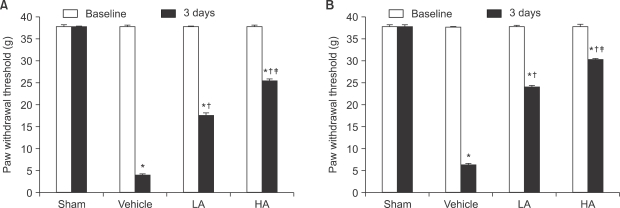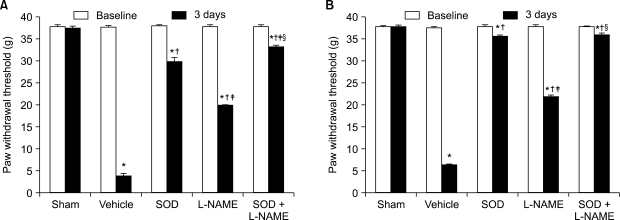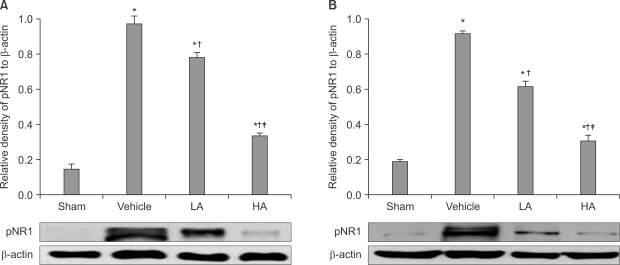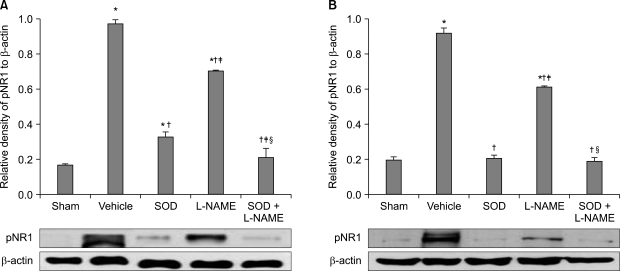1. Jänig W, Baron R. Complex regional pain syndrome is a disease of the central nervous system. Clin Auton Res. 2002; 12:150–164. PMID:
12269546.

2. Coderre TJ, Xanthos DN, Francis L, Bennett GJ. Chronic post-ischemia pain (CPIP): a novel animal model of complex regional pain syndrome-type I (CRPS-I; reflex sympathetic dystrophy) produced by prolonged hindpaw ischemia and reperfusion in the rat. Pain. 2004; 112:94–105. PMID:
15494189.

3. Kwak KH, Han CG, Lee SH, Jeon Y, Park SS, Kim SO, et al. Reactive oxygen species in rats with chronic postischemia pain. Acta Anaesthesiol Scand. 2009; 53:648–656. PMID:
19419360.

4. Kim HK, Park SK, Zhou JL, Taglialatela G, Chung K, Coggeshall RE, et al. Reactive oxygen species (ROS) play an important role in a rat model of neuropathic pain. Pain. 2004; 111:116–124. PMID:
15327815.

5. Hacimuftuoglu A, Handy CR, Goettl VM, Lin CG, Dane S, Stephens RL Jr. Antioxidants attenuate multiple phases of formalin induced nociceptive response in mice. Behav Brain Res. 2006; 173:211–216. PMID:
16919817.

6. Guedes RP, Bosco LD, Teixeira CM, Araújo AS, Llesuy S, Belló-Klein A, et al. Neuropathic pain modifies antioxidant activity in rat spinal cord. Neurochem Res. 2006; 31:603–609. PMID:
16770731.

7. Park ES, Gao X, Chung JM, Chung K. Levels of mitochondrial reactive oxygen species increase in rat neuropathic spinal dorsal horn neurons. Neurosci Lett. 2006; 391:108–111. PMID:
16183198.

8. Gao X, Kim HK, Chung JM, Chung K. Reactive oxygen species (ROS) are involved in enhancement of NMDA-receptor phosphorylation in animal models of pain. Pain. 2007; 131:262–271. PMID:
17317010.

9. Zou X, Lin Q, Willis WD. Enhanced phosphorylation of NMDA receptor 1 subunits in spinal cord dorsal horn and spinothalamic tract neurons after intradermal injection of capsaicin in rats. J Neurosci. 2000; 20:6989–6997. PMID:
10995844.

10. Coderre TJ, Melzack R. The contribution of excitatory amino acids to central sensitization and persistent nociception after formalin-induced tissue injury. J Neurosci. 1992; 12:3665–3670. PMID:
1326610.

11. Gao X, Kim HK, Chung JM, Chung K. Enhancement of NMDA receptor phosphorylation of the spinal dorsal horn and nucleus gracilis neurons in neuropathic rats. Pain. 2005; 116:62–72. PMID:
15936881.

12. Tripatara P, Patel NS, Webb A, Rathod K, Lecomte FM, Mazzon E, et al. Nitrite-derived nitric oxide protects the rat kidney against ischemia/reperfusion injury in vivo: role for xanthine oxidoreductase. J Am Soc Nephrol. 2007; 18:570–580. PMID:
17202421.

13. Radovic M, Miloradovic Z, Popovic T, Mihailovic-Stanojevic N, Jovovic D, Tomovic M, et al. Allopurinol and enalapril failed to conserve urinary NOx and sodium in ischemic acute renal failure in spontaneously hypertensive rats. Am J Nephrol. 2006; 26:388–399. PMID:
16900002.

14. Lee WY, Lee SM. Synergistic protective effect of ischemic preconditioning and allopurinol on ischemia/reperfusion injury in rat liver. Biochem Biophys Res Commun. 2006; 349:1087–1093. PMID:
16959212.

15. Nemeth N, Lesznyak T, Szokoly M, Furka I, Miko I. Allopurinol prevents erythrocyte deformability impairing but not the hematological alterations after limb ischemia reperfusion in rats. J Invest Surg. 2006; 19:47–56. PMID:
16546929.

16. Albuquerque RG, Sanson AJ, Malangoni MA. Allopurinol protects enterocytes from hypoxia-induced apoptosis in vivo. J Trauma. 2002; 53:415–420. PMID:
12352473.

17. Levy D, Zochodne DW. Local nitric oxide synthase activity in a model of neuropathic pain. Eur J Neurosci. 1998; 10:1846–1855. PMID:
9751155.

18. Caban A, Oczkowicz G, Abdel-Samad O, Cierpka L. Influence of ischemic preconditioning and nitric oxide on microcirculation and the degree of rat liver injury in the model of ischemia and reperfusion. Transplant Proc. 2006; 38:196–198. PMID:
16504701.

19. Halliwell B, Gutteridge JC. Free radicals in biology and medicine. 2007. 4th ed. New York: Oxford University Press;p. 22.
20. Salvemini D, Riley DP, Lennon PJ, Wang ZQ, Currie MG, Macarthur H, et al. Protective effects of a superoxide dismutase mimetic and peroxynitrite decomposition catalysts in endotoxin-induced intestinal damage. Br J Pharmacol. 1999; 127:685–692. PMID:
10401559.

21. Xia ZF, Hollyoak M, Barrow RE, He F, Muller MJ, Herndon DN. Superoxide dismutase and leupeptin prevent delayed reperfusion injury in the rat small intestine during burn shock. J Burn Care Rehabil. 1995; 16:111–117. PMID:
7775503.

22. Li C, Jackson RM. Reactive species mechanisms of cellular hypoxia-reoxygenation injury. Am J Physiol Cell Physiol. 2002; 282:C227–C241. PMID:
11788333.

23. Kim KW, Ha MJ, Jung KY, Kwak KH, Park SS, Lim DG. Reactive oxygen species and N-methyl-D-aspartate receptor-mediated central sensitization in hindlimb ischemia/reperfusion injury-induced neuropathic pain rats. Korean J Anesthesiol. 2009; 56:186–194.

24. Khalil Z, Khodr B. A role for free radicals and nitric oxide in delayed recovery in aged rats with chronic constriction nerve injury. Free Radic Biol Med. 2001; 31:430–439. PMID:
11498276.

25. Wang ZQ, Porreca F, Cuzzocrea S, Galen K, Lightfoot R, Masini E, et al. A newly identified role for superoxide in inflammatory pain. J Pharmacol Exp Ther. 2004; 309:869–878. PMID:
14988418.

26. Schwartz ES, Kim HY, Wang J, Lee I, Klann E, Chung JM, et al. Persistent pain is dependent on spinal mitochondrial antioxidant levels. J Neurosci. 2009; 29:159–168. PMID:
19129394.

27. Xu L, Mabuchi T, Katano T, Matsumura S, Okuda-Ashitaka E, Sakimura K, et al. Nitric oxide (NO) serves as a retrograde messenger to activate neuronal NO synthase in the spinal cord via NMDA receptors. Nitric Oxide. 2007; 17:18–24. PMID:
17548218.

28. Muscoli C, Mollace V, Wheatley J, Masini E, Ndengele M, Wang ZQ, et al. Superoxide-mediated nitration of spinal manganese superoxide dismutase: a novel pathway in N-methyl-D-aspartate-mediated hyperalgesia. Pain. 2004; 111:96–103. PMID:
15327813.

29. Woolf CJ. Evidence for a central component of post-injury pain hypersensitivity. Nature. 1983; 306:686–688. PMID:
6656869.

30. Masu M, Nakajima Y, Moriyoshi K, Ishii T, Akazawa C, Nakanashi S. Molecular characterization of NMDA and metabotropic glutamate receptors. Ann N Y Acad Sci. 1993; 707:153–164. PMID:
9137550.

31. Mori H, Mishina M. Structure and function of the NMDA receptor channel. Neuropharmacology. 1995; 34:1219–1237. PMID:
8570021.

32. Guix FX, Uribesalgo I, Coma M, Muñoz FJ. Physiology and pathophysiology of nitric oxide in the brain. Prog Neurobiol. 2005; 76:126–152. PMID:
16115721.
33. Zhang XC, Zhang YQ, Zhao ZQ. Different roles of two nitric oxide activated pathways in spinal long-term potentiation of C-fiber-evoked field potentials. Neuropharmacology. 2006; 50:748–754. PMID:
16427664.

34. Duarte ID, dos Santos IR, Lorenzetti BB, Ferreira SH. Analgesia by direct antagonism of nociceptor sensitization involves the arginine-nitric oxide cGMP pathway. Eur J Pharmacol. 1992; 217:225–227. PMID:
1330593.

35. Ferreira SH, Lorenzetti BB, Faccioli LH. Blockade of hyperalgesia and neurogenic oedema by topical application of nitroglycerin. Eur J Pharmacol. 1992; 217:207–209. PMID:
1425939.

36. Bulutcu F, Dogrul A, Güc MO. The involvement of nitric oxide in the analgesic effects of ketamine. Life Sci. 2002; 71:841–853. PMID:
12074943.

37. Granados-Soto V, Rufino MO, Gomes Lopes LD, Ferreira SH. Evidence for the involvement of the nitric oxide-cGMP pathway in the antinociception of morphine in the formalin test. Eur J Pharmacol. 1997; 340:177–180. PMID:
9537812.

38. Mixcoatl-Zecuatl T, Flores-Murrieta FJ, Granados-Soto V. The nitric oxide-cyclic GMP-protein kinase G-K+ channel pathway participates in the antiallodynic effect of spinal gabapentin. Eur J Pharmacol. 2006; 531:87–95. PMID:
16438951.

39. Ortiz MI, Castro-Olguin J, Peña-Samaniego N, Castañeda-Hernández G. Probable activation of the opioid receptor-nitric oxide-cyclic GMP-K+ channels pathway by codeine. Pharmacol Biochem Behav. 2005; 82:695–703. PMID:
16386786.

40. Ortiz MI, Granados-Soto V, Castañeda-Hernández G. The NO-cGMP-K+ channel pathway participates in the antinociceptive effect of diclofenac, but not of indomethacin. Pharmacol Biochem Behav. 2003; 76:187–195. PMID:
13679232.

41. de Moura RS, Rios AA, Santos EJ, Nascimento AB, de Castro Resende A, Neto ML, et al. Role of the NO-cGMP pathway in the systemic antinociceptive effect of clonidine in rats and mice. Pharmacol Biochem Behav. 2004; 78:247–253. PMID:
15219764.

42. Xanthos DN, Bennett GJ, Coderre TJ. Norepinephrine-induced nociception and vasoconstrictor hypersensitivity in rats with chronic post-ischemia pain. Pain. 2008; 137:640–651. PMID:
18079061.

43. Kim YC. Complex regional pain syndrome. Korean J Pain. 2004; 17(Suppl):104–108.

44. Milligan ED, Twining C, Chacur M, Biedenkapp J, O'Connor K, Poole S, et al. Spinal glia and proinflammatory cytokines mediate mirror-image neuropathic pain in rats. J Neurosci. 2003; 23:1026–1040. PMID:
12574433.

45. Twining CM, Sloane EM, Milligan ED, Chacur M, Martin D, Poole S, et al. Peri-sciatic proinflammatory cytokines, reactive oxygen species, and complement induce mirror-image neuropathic pain in rats. Pain. 2004; 110:299–309. PMID:
15275780.

46. Gordh T, Sharma HS. Chronic spinal nerve ligation induces microvascular permeability disturbances, astrocytic reaction, and structural changes in the rat spinal cord. Acta Neurochir Suppl. 2006; 96:335–340. PMID:
16671481.

47. Light AR, Perl ER. Reexamination of the dorsal root projection to the spinal dorsal horn including observations on the differential termination of coarse and fine fibers. J Comp Neurol. 1979; 186:117–131. PMID:
447880.

48. Koltzenburg M, Wall PD, McMahon SB. Does the right side know what the left is doing? Trends Neurosci. 1999; 22:122–127. PMID:
10199637.

49. Donaldson LF. Unilateral arthritis: contralateral effects. Trends Neurosci. 1999; 22:495–496. PMID:
10530993.

50. Kwak KH, Jung KY, Choi JY, Ryu T, Yeo JS, Park SS, et al. Contralateral allodynia and central change in the chronic post-ischemic pain model rats. Korean J Anesthesiol. 2009; 56:419–424.









 PDF
PDF Citation
Citation Print
Print


 XML Download
XML Download